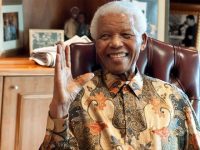A beacon of culture Located in the province of Kwilu, the Gungu Museum on Congolese…

Rwanda: interview with Cyrie Sendashonga, the widow of the late Seth Sendashonga, who was killed 26 years ago
Focus on Africa decided to interview Cyrie Sendashonga, the widow of the late Rwandan Minister Seth Sendashonga, who was killed in Kenya 26 years ago.
Can you kindly tell us something about the political activities of your late husband, Mr. Seth Sendashonga?
My husband was a political activist from early on in his youth, especially concerned about the situation of human rights and democracy in Rwanda. He came to be known during the period he was a student at the National University of Rwanda (1972-1975) especially in the year 1973 when there was an episode of persecution against Tutsi students who were expelled from the University and there was a widespread wind of mob violence directed mostly against Tutsi led by some Hutu students who were probably manipulated by some unscrupulous politicians or some security service agents. Sendashonga, himself a Hutu, wrote articles in the University students’ journal (‘Le Diapason’) in which he denounced and publicly condemned the violence against Tutsi and shared his view that the country should focus on its development priorities rather than depriving itself of precious skills by chasing members of the educated Tutsi ethnic group.
In 1974, he was elected to be the first President of a new student’s organization (known as AGER – Association Générale des Etudiants Rwandais) which included all Rwandan students in institutions of higher learning whether in Rwanda or abroad. As President of AGER, Sendashonga went on the record for opposing the installation of a one-party State which the military regime that was ruling Rwanda following the coup d’état which toppled the civilian President in July 1973, was imposing on Rwandans. This led him to be expelled from the University in October 1975 and he had to go into exile in Kenya to avoid being arrested.
It was during the years that he was living in Kenya that he began to interact with members of the Tutsi diaspora who had fled Rwanda over the years since the social revolution of 1959 which toppled the feudal monarchy system that had ruled Rwanda for several centuries. These Tutsi were behind the foundation of the Rwandan Patriotic Front (RPF) which invaded Rwanda in October 1990. Sendashonga joined the RPF in 1991 and was made Minister of Interior in the Government of national unity that was formed in July 1994 after the RPF took power following the horrific period of the Rwandan genocide in which several thousand Rwandans were killed and millions went into exile. As Minister of Interior, Sendashonga came soon to realize that the new RPF regime, especially the army under the command of Paul Kagame, was committing numerous crimes and other abuses of human rights. This led to major disagreements between him and Kagame which ended in his resignation from the Government in August 1995. He left Rwanda and went into exile for a second time in Kenya. He nevertheless tirelessly continued to raise awareness on the authoritarian drift of the RPF regime under Paul Kagame and the alarming abuses of human rights by the army, until he was assassinated on 16 May 1998.
Do you think that there is enough evidence that was Paul Kagame who gave the order to kill your husband?
Yes, there is enough evidence that it was Kagame who gave the order.
– The first hint came from the fact that there had already been an attempt to kill my husband in February 1996 in Nairobi just a few months after he had left Rwanda after resigning his position as Minister of Interior following major disagreements with Paul Kagame (then Vice-President and Minister of Defense) regarding the widespread criminal acts against the civilian population committed by members of the army. Sendashonga was denouncing the fact that no measures were taken by Kagame as Minister of Defense to punish the culprits and put an end to those acts. In November 1995, following a few months during which Sendashonga was practically under house arrest, he was allowed to leave the country and he returned to live in Kenya where I was then based with our children. A soldier of the Rwanda army called Francis Mugabo who was working as an administrative attaché in the Rwanda Embassy in Nairobi was caught red handed after attempting to shoot Sendashonga after luring him to a meeting on 26 February 1996. He was arrested and the Kenya Government asked for his diplomatic immunity to be waived so that he could be tried. The Rwandan government categorically refused and preferred to break the diplomatic relations with Kenya for several months following that incident.
– After the killing of Sendashonga was successfully carried out on 16 May 1998, some suspects were arrested and a trial took place in Kenya. They were eventually acquitted in May 2001 for lack of evidence beyond reasonable doubt. While acquitting the suspects, the presiding judge of the High Court of Kenya stated that he was persuaded that the murder of Sendashonga was political, ordered by the Rwandan government. Valuable information was collected in the process of the trial and one of the suspects, a certain David Akiki Kiwanuka who was an agent of the network of Rwanda’s secret service operating in Kenya, revealed in a subsequent interview he gave to a Canadian film maker in 2002 that the order to kill Sendashonga had come from the ‘High Office’ in Kigali (by then, Paul Kagame was President of Rwanda).
– Furthermore, the late Colonel Patrick Karegeya who was the Chief of the Rwandan External Intelligence Service at the time of Sendashonga’s killing, told me personally when I met him in 2011 (while he was living in exile in South Africa after his relationship with Paul Kagame had turned sour and himself got killed by agents of Kagame in December 2013), that the order to kill Sendashonga had indeed been given by Kagame himself. Karegeya informed me that a large sum of money amounting to US$ 100.000 (one hundred thousand US dollars) had been paid to a Kenyan businessman well acquainted to Kagame who had acted as an enabler by recruiting two Kenyan security officers who carried out the killing.
– Perhaps the most telling evidence of particular interest is the fact that Kagame himself made statements that can be assimilated to admission of guilt during a retreat of Rwanda government officials held on 9 March 2019 in Gabiro, Northern Rwanda. He bragged publicly on the murder of Sendashonga and why he thought he had to die, adding that he was not apologetic about it. He reiterated this stance during an interview he gave to the magazine Jeune Afrique (no. 3038 of March/April 2019). Those two occurrences led me to write on open letter to the Kenyan Government on 16 May 2019 asking for fresh investigations on the case since I considered that these statements from Kagame himself constitute new evidence. I have received no response so far.
Is it possible to prosecute Mr. Kagame, even though he is a head of state?
The fact that he is a head of state makes it difficult, or practically impossible, to prosecute him in a criminal procedure because he is protected by the clause on immunity of function. The Kenyan judiciary system has used this clause to explain why they cannot summon, nor indict, arrest or try him in a criminal court. However, there could be a possibility to launch a civil law suit procedure although this could also be difficult because there probably would be few lawyers who would be willing to take up the case by fear of retaliation from the Kagame regime given his security services are known to have arranged transnational assassinations of putative opponents. Personally, I am also not inclined to go through a civil suit approach as I believe Paul Kagame has to be tried in a criminal court for the crimes he committed and it is my sincere hope that this will happen one day.




